warning FIAT DOBLO COMBI 2015 2.G Workshop Manual
[x] Cancel search | Manufacturer: FIAT, Model Year: 2015, Model line: DOBLO COMBI, Model: FIAT DOBLO COMBI 2015 2.GPages: 323, PDF Size: 46.77 MB
Page 115 of 323
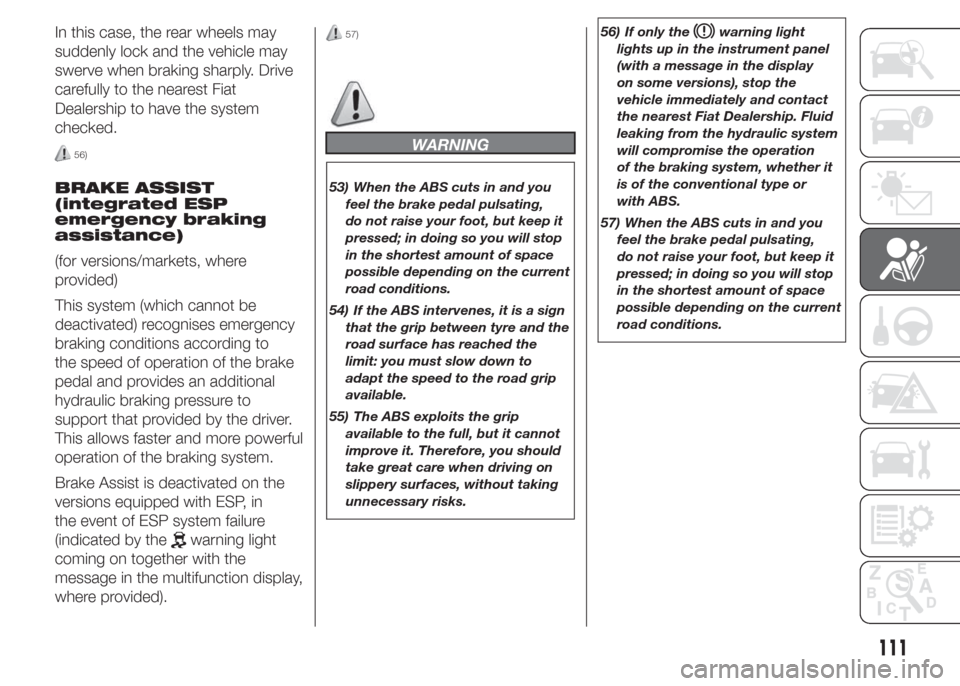
In this case, the rear wheels may
suddenly lock and the vehicle may
swerve when braking sharply. Drive
carefully to the nearest Fiat
Dealership to have the system
checked.
56)
BRAKE ASSIST
(integrated ESP
emergency braking
assistance)
(for versions/markets, where
provided)
This system (which cannot be
deactivated) recognises emergency
braking conditions according to
the speed of operation of the brake
pedal and provides an additional
hydraulic braking pressure to
support that provided by the driver.
This allows faster and more powerful
operation of the braking system.
Brake Assist is deactivated on the
versions equipped with ESP, in
the event of ESP system failure
(indicated by the
warning light
coming on together with the
message in the multifunction display,
where provided).
57)
WARNING
53) When the ABS cuts in and you
feel the brake pedal pulsating,
do not raise your foot, but keep it
pressed; in doing so you will stop
in the shortest amount of space
possible depending on the current
road conditions.
54) If the ABS intervenes, it is a sign
that the grip between tyre and the
road surface has reached the
limit: you must slow down to
adapt the speed to the road grip
available.
55) The ABS exploits the grip
available to the full, but it cannot
improve it. Therefore, you should
take great care when driving on
slippery surfaces, without taking
unnecessary risks.56) If only the
warning light
lights up in the instrument panel
(with a message in the display
on some versions), stop the
vehicle immediately and contact
the nearest Fiat Dealership. Fluid
leaking from the hydraulic system
will compromise the operation
of the braking system, whether it
is of the conventional type or
with ABS.
57) When the ABS cuts in and you
feel the brake pedal pulsating,
do not raise your foot, but keep it
pressed; in doing so you will stop
in the shortest amount of space
possible depending on the current
road conditions.
111
Page 116 of 323
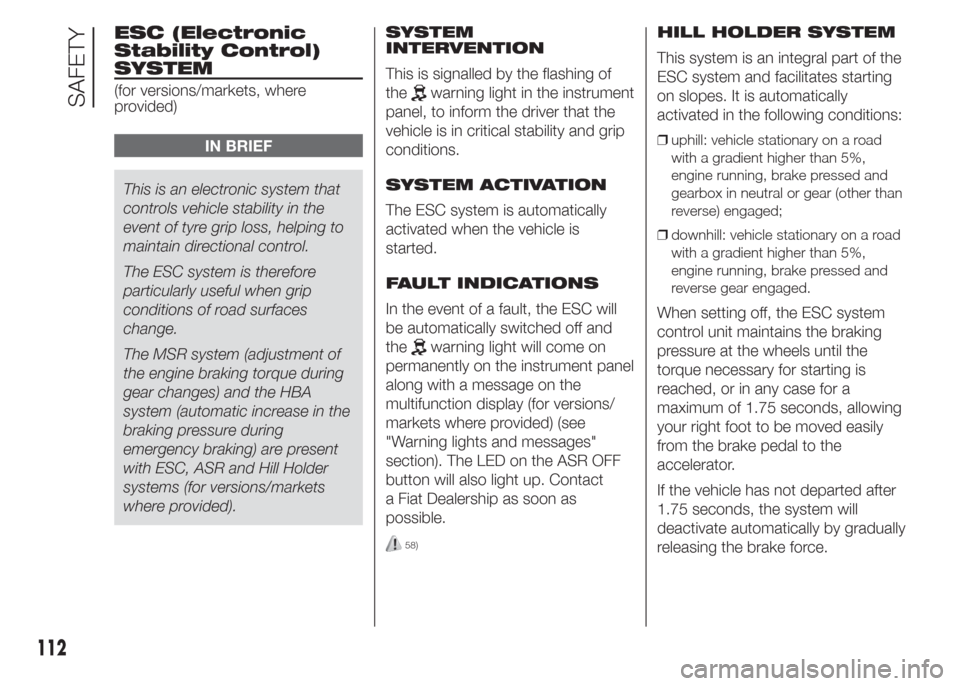
ESC (Electronic
Stability Control)
SYSTEM
(for versions/markets, where
provided)
IN BRIEF
This is an electronic system that
controls vehicle stability in the
event of tyre grip loss, helping to
maintain directional control.
The ESC system is therefore
particularly useful when grip
conditions of road surfaces
change.
The MSR system (adjustment of
the engine braking torque during
gear changes) and the HBA
system (automatic increase in the
braking pressure during
emergency braking) are present
with ESC, ASR and Hill Holder
systems (for versions/markets
where provided).SYSTEM
INTERVENTION
This is signalled by the flashing of
the
warning light in the instrument
panel, to inform the driver that the
vehicle is in critical stability and grip
conditions.
SYSTEM ACTIVATION
The ESC system is automatically
activated when the vehicle is
started.
FAULT INDICATIONS
In the event of a fault, the ESC will
be automatically switched off and
the
warning light will come on
permanently on the instrument panel
along with a message on the
multifunction display (for versions/
markets where provided) (see
"Warning lights and messages"
section). The LED on the ASR OFF
button will also light up. Contact
a Fiat Dealership as soon as
possible.
58)
HILL HOLDER SYSTEM
This system is an integral part of the
ESC system and facilitates starting
on slopes. It is automatically
activated in the following conditions:
❒uphill: vehicle stationary on a road
with a gradient higher than 5%,
engine running, brake pressed and
gearbox in neutral or gear (other than
reverse) engaged;
❒downhill: vehicle stationary on a road
with a gradient higher than 5%,
engine running, brake pressed and
reverse gear engaged.
When setting off, the ESC system
control unit maintains the braking
pressure at the wheels until the
torque necessary for starting is
reached, or in any case for a
maximum of 1.75 seconds, allowing
your right foot to be moved easily
from the brake pedal to the
accelerator.
If the vehicle has not departed after
1.75 seconds, the system will
deactivate automatically by gradually
releasing the brake force.
112
SAFETY
Page 117 of 323
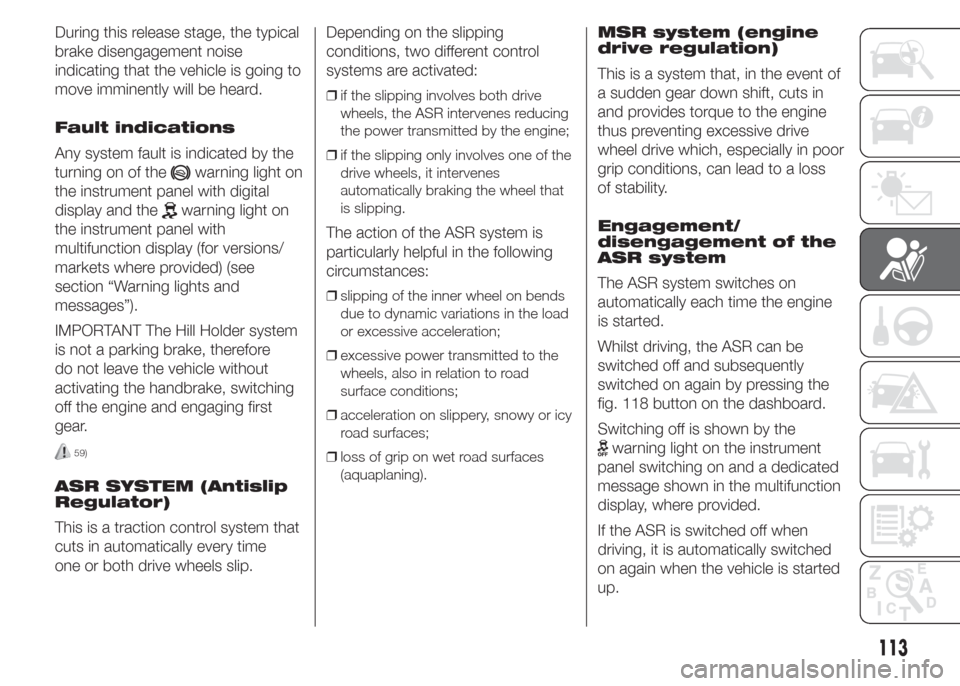
During this release stage, the typical
brake disengagement noise
indicating that the vehicle is going to
move imminently will be heard.
Fault indications
Any system fault is indicated by the
turning on of the
warning light on
the instrument panel with digital
display and the
warning light on
the instrument panel with
multifunction display (for versions/
markets where provided) (see
section “Warning lights and
messages”).
IMPORTANT The Hill Holder system
is not a parking brake, therefore
do not leave the vehicle without
activating the handbrake, switching
off the engine and engaging first
gear.
59)
ASR SYSTEM (Antislip
Regulator)
This is a traction control system that
cuts in automatically every time
one or both drive wheels slip.Depending on the slipping
conditions, two different control
systems are activated:
❒if the slipping involves both drive
wheels, the ASR intervenes reducing
the power transmitted by the engine;
❒if the slipping only involves one of the
drive wheels, it intervenes
automatically braking the wheel that
is slipping.
The action of the ASR system is
particularly helpful in the following
circumstances:
❒slipping of the inner wheel on bends
due to dynamic variations in the load
or excessive acceleration;
❒excessive power transmitted to the
wheels, also in relation to road
surface conditions;
❒acceleration on slippery, snowy or icy
road surfaces;
❒loss of grip on wet road surfaces
(aquaplaning).
MSR system (engine
drive regulation)
This is a system that, in the event of
a sudden gear down shift, cuts in
and provides torque to the engine
thus preventing excessive drive
wheel drive which, especially in poor
grip conditions, can lead to a loss
of stability.
Engagement/
disengagement of the
ASR system
The ASR system switches on
automatically each time the engine
is started.
Whilst driving, the ASR can be
switched off and subsequently
switched on again by pressing the
fig. 118 button on the dashboard.
Switching off is shown by the
warning light on the instrument
panel switching on and a dedicated
message shown in the multifunction
display, where provided.
If the ASR is switched off when
driving, it is automatically switched
on again when the vehicle is started
up.
113
Page 118 of 323
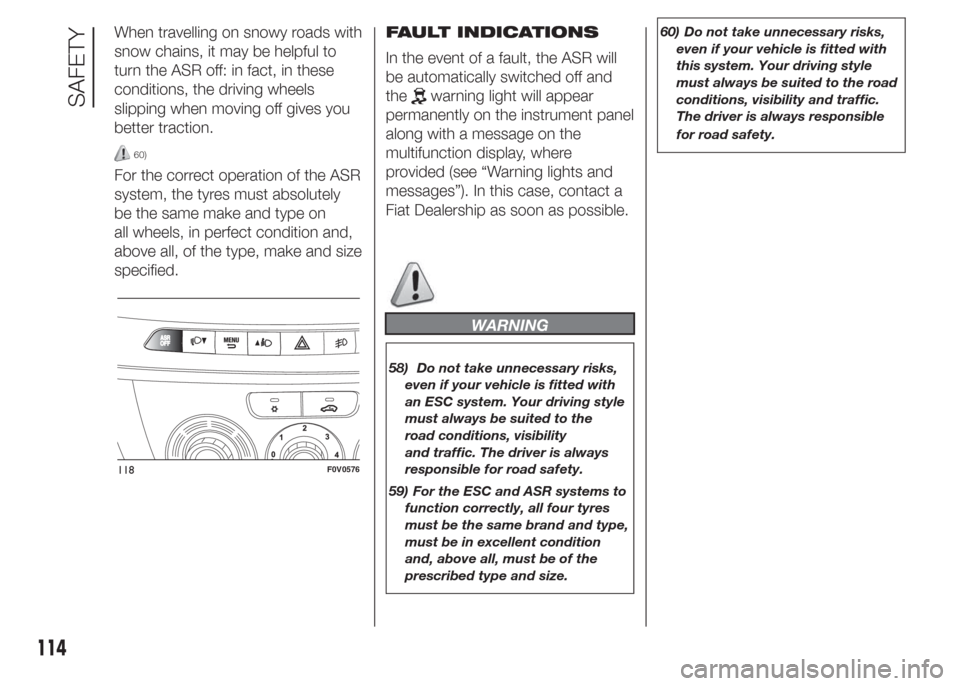
When travelling on snowy roads with
snow chains, it may be helpful to
turn the ASR off: in fact, in these
conditions, the driving wheels
slipping when moving off gives you
better traction.
60)
For the correct operation of the ASR
system, the tyres must absolutely
be the same make and type on
all wheels, in perfect condition and,
above all, of the type, make and size
specified.FAULT INDICATIONS
In the event of a fault, the ASR will
be automatically switched off and
the
warning light will appear
permanently on the instrument panel
along with a message on the
multifunction display, where
provided (see “Warning lights and
messages”). In this case, contact a
Fiat Dealership as soon as possible.
WARNING
58) Do not take unnecessary risks,
even if your vehicle is fitted with
an ESC system. Your driving style
must always be suited to the
road conditions, visibility
and traffic. The driver is always
responsible for road safety.
59) For the ESC and ASR systems to
function correctly, all four tyres
must be the same brand and type,
must be in excellent condition
and, above all, must be of the
prescribed type and size.60) Do not take unnecessary risks,
even if your vehicle is fitted with
this system. Your driving style
must always be suited to the road
conditions, visibility and traffic.
The driver is always responsible
for road safety.
118F0V0576
114
SAFETY
Page 120 of 323

IMPORTANT The backrest is
correctly secured when the red
band fig. 122 on backrest folding
handles A disappears. This red band
indicates that the backrest is not
secured.IMPORTANT After putting the rear
seats (for Doblò/Doblò Combi
versions) back to their normal
operating position, refit the seat belt
so that it is ready for use.
63)
ADJUSTING THE SEAT
BELT HEIGHT
64) 65)
The seat belt height can be adjusted
to various positions using the
regulator on the central pillar.
Always adjust the height of the seat
belts to fit the person wearing it:
this precaution could greatly reduce
the risk of injury in the event of
collision.
Correct adjustment is obtained
when the belt passes approximately
half way between the shoulder
and the neck.
WARNING
61) Never press button C fig. 119
when travelling.
62) Remember that, in the event of a
violent collision, back-seat
passengers not wearing seat belts
represent a serious danger to
the front-seat passengers as well
as to themselves.
63) Make sure that the backrest is
correctly secured on both sides
(red bands B not visible) to
prevent it from moving forward in
the event of sharp braking,
causing injuries to passengers.
64) The height of the seat belts must
be adjusted with the vehicle
stationary.
65) After the height adjustment,
always check that the regulator is
locked in one of the preset
positions. To do this, push
downwards to enable the locking
device to click if the grip has
not been released in one of the
possible positions.
121F0V0197
122F0V0127
116
SAFETY
Page 121 of 323
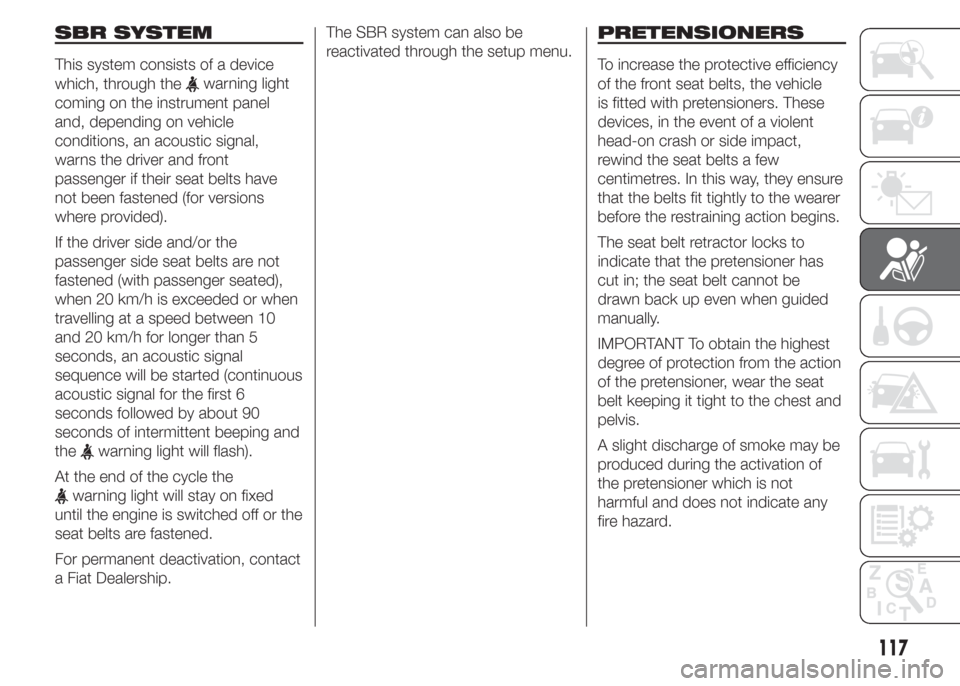
SBR SYSTEM
This system consists of a device
which, through the
warning light
coming on the instrument panel
and, depending on vehicle
conditions, an acoustic signal,
warns the driver and front
passenger if their seat belts have
not been fastened (for versions
where provided).
If the driver side and/or the
passenger side seat belts are not
fastened (with passenger seated),
when 20 km/h is exceeded or when
travelling at a speed between 10
and 20 km/h for longer than 5
seconds, an acoustic signal
sequence will be started (continuous
acoustic signal for the first 6
seconds followed by about 90
seconds of intermittent beeping and
the
warning light will flash).
At the end of the cycle the
warning light will stay on fixed
until the engine is switched off or the
seat belts are fastened.
For permanent deactivation, contact
a Fiat Dealership.The SBR system can also be
reactivated through the setup menu.
PRETENSIONERS
To increase the protective efficiency
of the front seat belts, the vehicle
is fitted with pretensioners. These
devices, in the event of a violent
head-on crash or side impact,
rewind the seat belts a few
centimetres. In this way, they ensure
that the belts fit tightly to the wearer
before the restraining action begins.
The seat belt retractor locks to
indicate that the pretensioner has
cut in; the seat belt cannot be
drawn back up even when guided
manually.
IMPORTANT To obtain the highest
degree of protection from the action
of the pretensioner, wear the seat
belt keeping it tight to the chest and
pelvis.
A slight discharge of smoke may be
produced during the activation of
the pretensioner which is not
harmful and does not indicate any
fire hazard.
117
Page 122 of 323
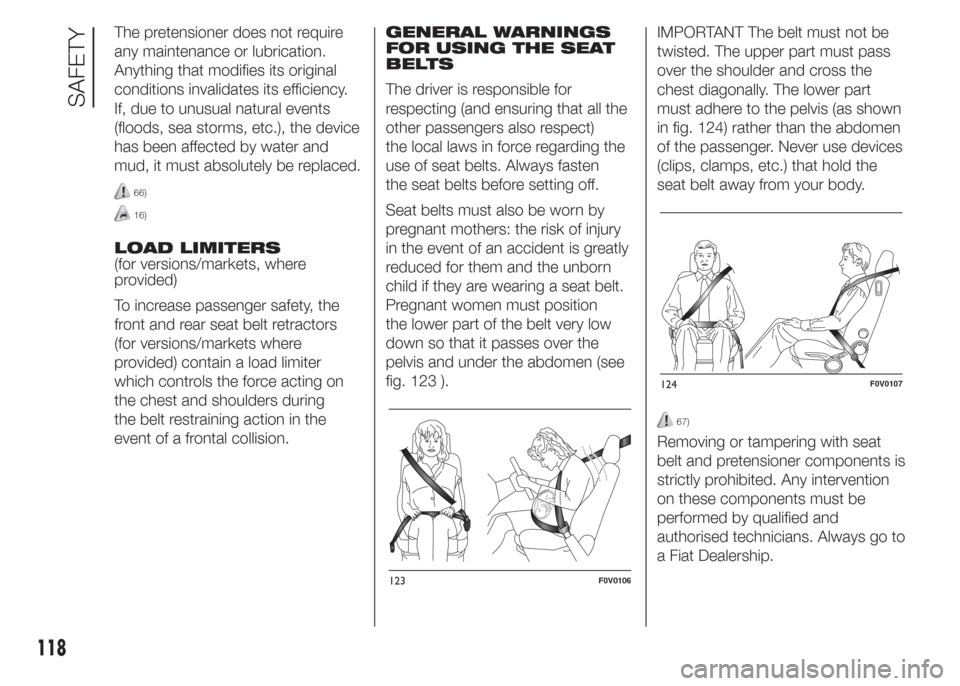
The pretensioner does not require
any maintenance or lubrication.
Anything that modifies its original
conditions invalidates its efficiency.
If, due to unusual natural events
(floods, sea storms, etc.), the device
has been affected by water and
mud, it must absolutely be replaced.
66)
16)
LOAD LIMITERS
(for versions/markets, where
provided)
To increase passenger safety, the
front and rear seat belt retractors
(for versions/markets where
provided) contain a load limiter
which controls the force acting on
the chest and shoulders during
the belt restraining action in the
event of a frontal collision.GENERAL WARNINGS
FOR USING THE SEAT
BELTS
The driver is responsible for
respecting (and ensuring that all the
other passengers also respect)
the local laws in force regarding the
use of seat belts. Always fasten
the seat belts before setting off.
Seat belts must also be worn by
pregnant mothers: the risk of injury
in the event of an accident is greatly
reduced for them and the unborn
child if they are wearing a seat belt.
Pregnant women must position
the lower part of the belt very low
down so that it passes over the
pelvis and under the abdomen (see
fig. 123 ).IMPORTANT The belt must not be
twisted. The upper part must pass
over the shoulder and cross the
chest diagonally. The lower part
must adhere to the pelvis (as shown
in fig. 124) rather than the abdomen
of the passenger. Never use devices
(clips, clamps, etc.) that hold the
seat belt away from your body.
67)
Removing or tampering with seat
belt and pretensioner components is
strictly prohibited. Any intervention
on these components must be
performed by qualified and
authorised technicians. Always go to
a Fiat Dealership.
123F0V0106
124F0V0107
118
SAFETY
Page 123 of 323
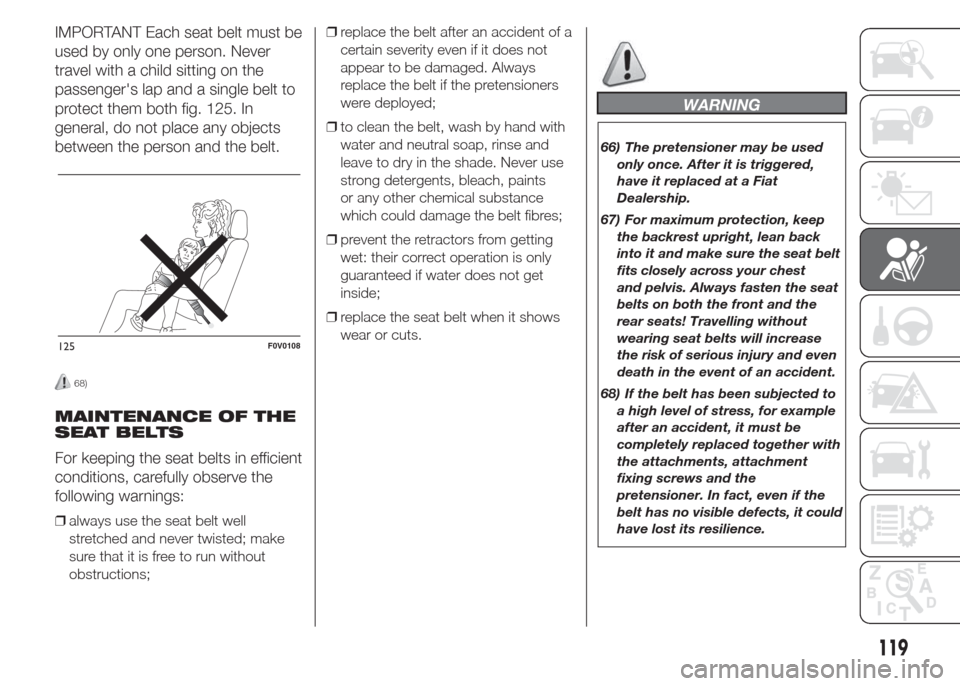
IMPORTANT Each seat belt must be
used by only one person. Never
travel with a child sitting on the
passenger's lap and a single belt to
protect them both fig. 125. In
general, do not place any objects
between the person and the belt.
68)
MAINTENANCE OF THE
SEAT BELTS
For keeping the seat belts in efficient
conditions, carefully observe the
following warnings:
❒always use the seat belt well
stretched and never twisted; make
sure that it is free to run without
obstructions;❒replace the belt after an accident of a
certain severity even if it does not
appear to be damaged. Always
replace the belt if the pretensioners
were deployed;
❒to clean the belt, wash by hand with
water and neutral soap, rinse and
leave to dry in the shade. Never use
strong detergents, bleach, paints
or any other chemical substance
which could damage the belt fibres;
❒prevent the retractors from getting
wet: their correct operation is only
guaranteed if water does not get
inside;
❒replace the seat belt when it shows
wear or cuts.
WARNING
66) The pretensioner may be used
only once. After it is triggered,
have it replaced at a Fiat
Dealership.
67) For maximum protection, keep
the backrest upright, lean back
into it and make sure the seat belt
fits closely across your chest
and pelvis. Always fasten the seat
belts on both the front and the
rear seats! Travelling without
wearing seat belts will increase
the risk of serious injury and even
death in the event of an accident.
68) If the belt has been subjected to
a high level of stress, for example
after an accident, it must be
completely replaced together with
the attachments, attachment
fixing screws and the
pretensioner. In fact, even if the
belt has no visible defects, it could
have lost its resilience.
125F0V0108
119
Page 127 of 323
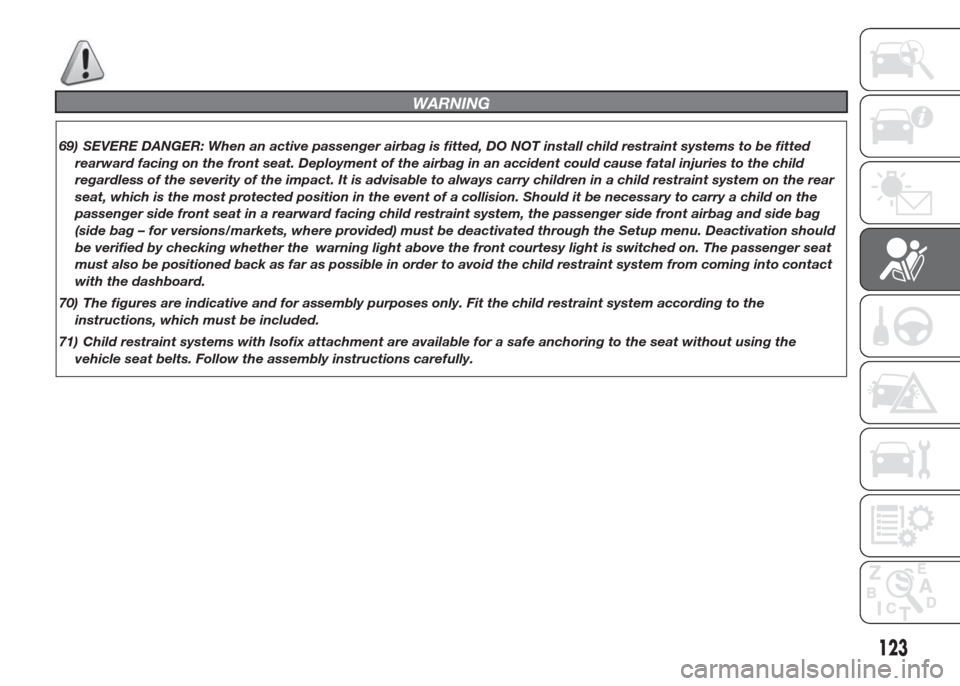
WARNING
69) SEVERE DANGER: When an active passenger airbag is fitted, DO NOT install child restraint systems to be fitted
rearward facing on the front seat. Deployment of the airbag in an accident could cause fatal injuries to the child
regardless of the severity of the impact. It is advisable to always carry children in a child restraint system on the rear
seat, which is the most protected position in the event of a collision. Should it be necessary to carry a child on the
passenger side front seat in a rearward facing child restraint system, the passenger side front airbag and side bag
(side bag – for versions/markets, where provided) must be deactivated through the Setup menu. Deactivation should
be verified by checking whether the warning light above the front courtesy light is switched on. The passenger seat
must also be positioned back as far as possible in order to avoid the child restraint system from coming into contact
with the dashboard.
70) The figures are indicative and for assembly purposes only. Fit the child restraint system according to the
instructions, which must be included.
71) Child restraint systems with Isofix attachment are available for a safe anchoring to the seat without using the
vehicle seat belts. Follow the assembly instructions carefully.
123
Page 131 of 323
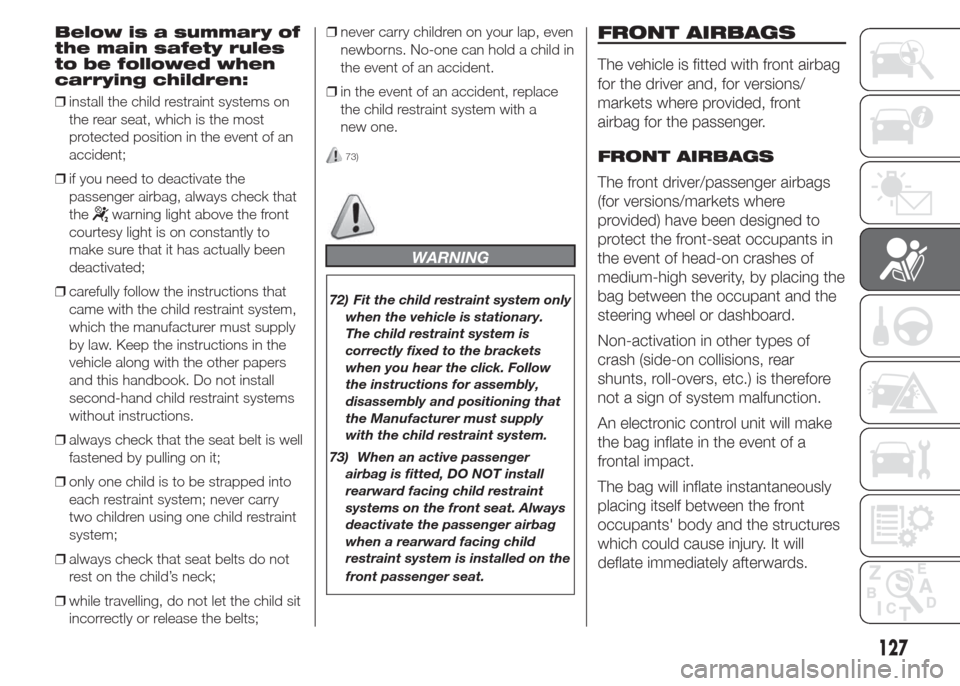
Below is a summary of
the main safety rules
to be followed when
carrying children:
❒install the child restraint systems on
the rear seat, which is the most
protected position in the event of an
accident;
❒if you need to deactivate the
passenger airbag, always check that
the
warning light above the front
courtesy light is on constantly to
make sure that it has actually been
deactivated;
❒carefully follow the instructions that
came with the child restraint system,
which the manufacturer must supply
by law. Keep the instructions in the
vehicle along with the other papers
and this handbook. Do not install
second-hand child restraint systems
without instructions.
❒always check that the seat belt is well
fastened by pulling on it;
❒only one child is to be strapped into
each restraint system; never carry
two children using one child restraint
system;
❒always check that seat belts do not
rest on the child’s neck;
❒while travelling, do not let the child sit
incorrectly or release the belts;❒never carry children on your lap, even
newborns. No-one can hold a child in
the event of an accident.
❒in the event of an accident, replace
the child restraint system with a
new one.
73)
WARNING
72) Fit the child restraint system only
when the vehicle is stationary.
The child restraint system is
correctly fixed to the brackets
when you hear the click. Follow
the instructions for assembly,
disassembly and positioning that
the Manufacturer must supply
with the child restraint system.
73) When an active passenger
airbag is fitted, DO NOT install
rearward facing child restraint
systems on the front seat. Always
deactivate the passenger airbag
when a rearward facing child
restraint system is installed on the
front passenger seat.
FRONT AIRBAGS
The vehicle is fitted with front airbag
for the driver and, for versions/
markets where provided, front
airbag for the passenger.
FRONT AIRBAGS
The front driver/passenger airbags
(for versions/markets where
provided) have been designed to
protect the front-seat occupants in
the event of head-on crashes of
medium-high severity, by placing the
bag between the occupant and the
steering wheel or dashboard.
Non-activation in other types of
crash (side-on collisions, rear
shunts, roll-overs, etc.) is therefore
not a sign of system malfunction.
An electronic control unit will make
the bag inflate in the event of a
frontal impact.
The bag will inflate instantaneously
placing itself between the front
occupants' body and the structures
which could cause injury. It will
deflate immediately afterwards.
127